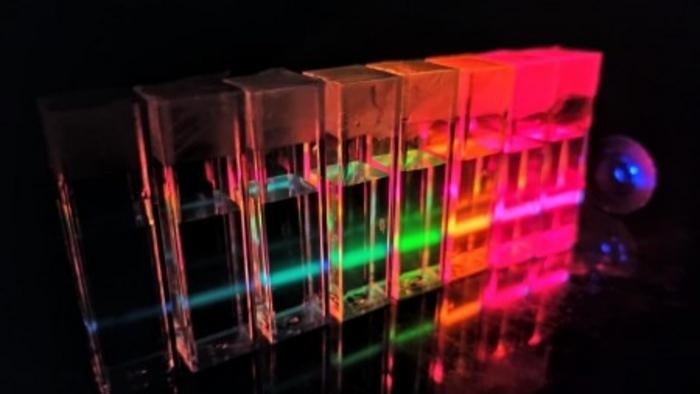Researchers from the University of São Paulo and Kiel University offered a novel approach to monitoring QD creation. Due to the phenomenon of quantum confinement, QDs are semiconductor nanoparticles whose emissive properties are directly correlated with dot size. This makes it possible to intelligently plan for the desired luminosity through the monitoring and control of crystal development during the synthesis of QDs in solution. This study was published in the journal Scientific Reports.
 Cadmium telluride (CdTe) quantum dots of different sizes emitting light in response to excitation by UV laser. Image Credit: Pedro Felipe Garcia Martins da Costa
Cadmium telluride (CdTe) quantum dots of different sizes emitting light in response to excitation by UV laser. Image Credit: Pedro Felipe Garcia Martins da Costa
The process by which an object absorbs light at one wavelength and subsequently reemits it at a different wavelength is known as luminosity. Through light absorption, electrons in the material's ground state are stimulated to a higher energy state.
Electrons decay to lower energy states, such as the ground state, after a period of time characteristic of each excited state, at which point they release light. This phenomenon is used in numerous technical applications involving highly reproducible, efficient, and easily downsized emission devices.
Quantum Dots (QDs), which are being utilized in high-resolution screens, LEDs, solar panels, and other sensors, including those used for precision medical imaging, are among the materials with the highest luminescence efficiency.
When QDs are functionalized with different kinds of molecules, they can interact with other molecules or cellular structures to study biological processes at the molecular level.
We used cadmium telluride [CdTe] as a model system and controlled nanoparticle growth in a heated aqueous solution via in situ luminescence analysis.
Pedro Felipe Garcia Martins da Costa, Ph.D. Candidate and Study First Author, University of São Paulo
The technique allows scientists to observe real-time changes in the solution without affecting QD synthesis, enabling them to monitor crystal growth by examining the color (wavelength) of the emitted light.
QDs are synthesized by mixing cadmium (Cd2+) and tellurium (Te2-) precursor solutions in the presence of a size control reagent. The temperature is raised and the chemical reaction begins via telluride and cadmium ion clustering. As the reaction proceeds, additional units of CdTe join the cluster spherically in a process known as self-assembly. Nanoparticle size can be estimated thanks to rapid and precise monitoring of the emission frequencies.
Leonnam Gotardo Merizio, Postdoctoral Researcher, Study Second Author, University of São Paulo
Costa said, “QDs of CdTe with a diameter of 1-2 nm emit in the blue and green regions of the visible spectrum. Larger QDs, measuring 4-5 nm, emit at lower frequencies, as yellow and red respectively.”
Costa claims that the new approach is superior to the traditional synthesis process in a number of ways.
In the conventional technique, you have to take small samples of the solution to measure QD size, but the in-situ technique lets you do so as the process is under way, without having to interfere with the reaction medium to take samples so that more spectra can be obtained per unit of time, reaction volume is not affected, and unnecessary waste is avoided.
Pedro Felipe Garcia Martins da Costa, Ph.D. Candidate and Study First Author, University of São Paulo
“The emission color of the QDs of interest can therefore be controlled far more precisely. The equipment that delivers the excitation light via optical fiber at the appropriate wavelength also collects the emitted light and determines its characteristic frequency in the RGB [red, green, and blue] color system. It is worth noting that control of the RGB system is relevant to image formation in several luminescent devices, such as monitors and smartphone displays,” he explained.
He also mentioned that X-ray diffraction, transmission electron microscopy, ultraviolet-visible absorption spectroscopy, and infrared vibration spectroscopy were used to analyze the QDs that were manufactured in this manner.
British scientist Herbert Fröhlich (1905–91), of German descent, made a theoretical prediction about the existence of QDs in 1937. In the 1980s, Louis Brus (born 1943) in the United States and Alexey Ekimov (born 1945) in the then Soviet Union made the first independent observations of quantum confinement in semiconductor nanoparticles.
French-American physicist Moungi Bawendi (born 1961) greatly improved QD synthesis techniques in the 1990s. For their contributions to the discipline, Ekimov, Brus, and Bawendi were granted the 2023 Nobel Prize in Chemistry.
“Quantum confinement gives QDs the capacity to confine electrons in three dimensions, making quantum phenomena more evident and characterizing them as intermediate materials between atoms, molecules, and larger crystalline arrays,” Costa said
Camargo said, “Many papers have been published on the synthesis of QDs made of CdTe. Our study’s main contribution relates to the development and application of a highly versatile in situ luminescence measurement system. The methodology enabled us to infer the size of the crystalline nanoparticles and to characterize the formation of intermediate compounds in the chemical reactions by in situ association with other techniques that permit chemical and/or structural analysis [FT-IR, Raman, DRX, etc]. This evolution of synthesis optimizes chemical yields and saves energy.”
Journal Reference:
da Costa, P. F. G. M., et al. (2024) Real-time monitoring of CdTe quantum dots growth in aqueous solution. Scientific Reports. doi.org/10.1038/s41598-024-57810-8.